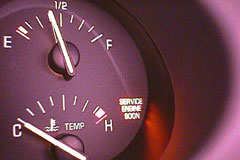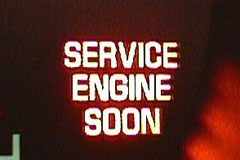
Vehicles with computerized engine controls are equipped with a noteworthy and sometimes misunderstood warning lamp on the instrument panel-the MIL. This computer controlled warning lamp has been the subject of some confusion among vehicle owners due to its mysterious appearances, indications, and interpreted meanings. Some of the confusion arises from various manufacturers calling this light by slightly different names over the years.
The technically correct name for this warning lamp is the "Malfunction Indicator Lamp" or "MIL". However, it has appeared on the instrument panel as Check Engine, Service Engine Soon, and Power LossLimited to name a few. When the ignition key is first turned ON (with engine not running), the MIL should light to show it is working. To correctly identify the MIL for your vehicle, consult the vehicle owner's manual to determine the location and appearance on the instrument panel.
The basic reason for the MIL is to keep computerized vehicles in peak operating condition. Vehicle emission standards require that electronically controlled engine components and emission system related devices work correctly. Simply stated, the MIL is a warning lamp to inform drivers of problems with electronic engine or emission control system components.
When the MIL is "ON", it is an indication that the vehicle's computer has identified a malfunction in the engine, electrical circuits, emissions, or related components. The capability of vehicle computers to identify problems is called On-Board Diagnostics (OBD). For 1996 and newer vehicles, the current version of computer problem identification is On-Board DiagnosticII. OBDII is the second generation of an enhanced vehicle diagnostic system that monitors numerous engine and emissions functions.
Depending on the type and severity of a problem, the MIL may be ON continuously, periodically ON, or flashing ON/OFF. A continuously illuminated MIL indicates the computer has identified a problem that is still present. Do not ignore an illuminated MIL just because the vehicle does not appear to have a serious driving problem. Modern engine control computers are very good at managing most malfunctions, and can continue to operate the engine reasonably well with limited conditions. Continuing to drive a vehicle with the MIL continuously illuminated is neither wise nor recommended. If left uncorrected, a vehicle with an illuminated MIL may produce high emissions, use more fuel, and seriously damage engine related components. Schedule your vehicle for service.
Sometimes the MIL may turn ON, then after a brief period of time-turn OFF. Periodic illumination of the MIL can mean the problem is an intermittent or borderline problem. If the MIL is periodically ON, have your vehicle checked by a technician as soon as possible.

A rapidly flashing MIL is a warning that component damage will likely occur and the malfunction needs immediate attention. Newer vehicles with OBDII systems flash the MIL if a computer-identified problem is very serious. An engine misfire, which is usually noticeable to the driver, is a type of malfunction that can cause an MIL to flash. If the MIL is flashing: reduce speed, avoid hard acceleration, and have a technician check the vehicle right away to prevent expensive repairs.
When the vehicle's computer identifies a malfunction, it will turn on the MIL and store a Diagnostic Trouble Code (DTC) in the computer memory. DTC's stored in the computer memory can help technicians to diagnose and repair the computer identified problem. There are many possibilities of fault codes depending on the type of problem. In addition to storing codes, OBDII systems will store diagnostic information and historical data to assist automotive technicians.
Technicians can use electronic scan tools to communicate with the vehicle computer and retrieve this diagnostic information. A misconception is that automotive repair facilities have computer scan tools that tell technicians what is wrong with the car. While scan tools are very helpful, many physical and mechanical aspects of vehicles cannot be sensed electronically. Automotive technicians are trained to examine the electronic data, mechanical components, and current technical information for an accurate diagnosis.
Don't panic if the MIL illuminates. The MIL serves as a warning to the driver that the computer has found a problem. Some computer-identified problems can be very minor and easily repaired. For example: OBDII vehicles may light the MIL due to a loose gas cap! The true meaning of an illuminated MIL on your vehicle will have to be determined by a qualified automotive technician.




